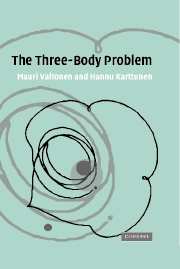Book contents
- Frontmatter
- Contents
- Preface
- 1 Astrophysics and the three-body problem
- 2 Newtonian mechanics
- 3 The two-body problem
- 4 Hamiltonian mechanics
- 5 The planar restricted circular three-body problem and other special cases
- 6 Three-body scattering
- 7 Escape in the general three-body problem
- 8 Scattering and capture in the general problem
- 9 Perturbations in hierarchical systems
- 10 Perturbations in strong three-body encounters
- 11 Some astrophysical problems
- References
- Author index
- Subject index
9 - Perturbations in hierarchical systems
Published online by Cambridge University Press: 04 December 2009
- Frontmatter
- Contents
- Preface
- 1 Astrophysics and the three-body problem
- 2 Newtonian mechanics
- 3 The two-body problem
- 4 Hamiltonian mechanics
- 5 The planar restricted circular three-body problem and other special cases
- 6 Three-body scattering
- 7 Escape in the general three-body problem
- 8 Scattering and capture in the general problem
- 9 Perturbations in hierarchical systems
- 10 Perturbations in strong three-body encounters
- 11 Some astrophysical problems
- References
- Author index
- Subject index
Summary
Complete analytical solutions are not available for systems with more than two bodies. However, it is possible to describe three-body orbits by approximate methods when the system is hierarchical, i.e. if there is a clearly defined binary and a third body which stays separate from the binary. These methods may be validated by comparison with numerical orbit integrations. Then we may take exact two-body orbits as a first approximation, and the effects of other bodies and other disturbances are taken into account as small forces which make the true trajectory deviate from this reference orbit.
Whenanalysing perturbations we have to make some approximations that depend on the form of the perturbing force. Thus perturbation theory is a collection of various methods applicable in different situations rather than a single theory. In this chapter we will study a classical method that applies to the usual orbital elements. Another method will be discussed in the next chapter.
The problem which we consider by using this method is the long term evolution of a binary orbit when it is perturbed by a distant companion. This applies especially to triple stars and to the stability of planetary orbits around binary members.
Osculating elements
Consider the motion of a planet in a heliocentric xyz-frame. At the moment t = t0 the planet is at (x0, y0, z0).
Information
- Type
- Chapter
- Information
- The Three-Body Problem , pp. 221 - 239Publisher: Cambridge University PressPrint publication year: 2006
